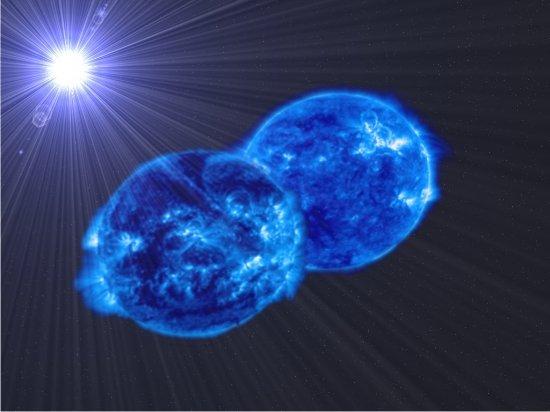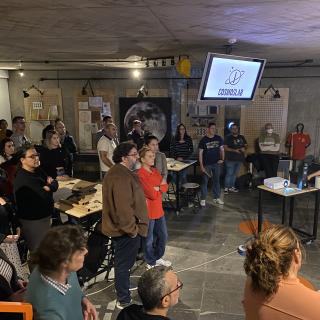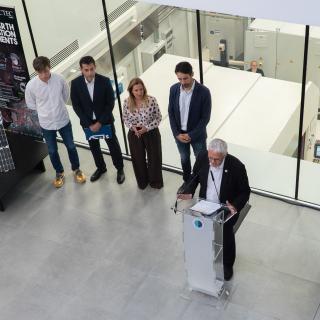In our Galaxy a large fraction of the stars are formed in binary systems, or multiple star systems, and some of these are referred to as “eclipsing” which means that the two or more stars observed from Earth undergo eclipses between them because their orbits are edge-on as seen by us. One of these systems is the eclipsing binary MY Camelopardalis (usually referred to as MY Cam), which is one of the most massive of these systems known. A recent article has been published about this binary using observations taken at the Calar Alto Observatory (Almería) and authored by astronomers from the University of Alicante, the Astrobiology Centre of the Higher Council for Scientific Research (CAB-CSIC) and the Astrophysics Institute of the Canaries (IAC) together with amateur astronomers.
In the article they conclude that MY Cam is the most massive binary yet observed whose components, two stars of spectral type O (blue, very hot, and very luminous) with masses 38 and 32 times that of the Sun, are still on the main sequence (still burning their initial hydrogen fuel), and they are very close together, with an orbital period of less than 1.2 days, which is the shortest period known for stars of this type.
The combination of these two measurements indicates that the binary formed virtually in the state it is in now, in other words, the stars were almost in contact at the time of formations.
The predictable evolution of the system will lead to the merger of the two stars into one object with a mass 60 times that of the sun, before either of them has had time to evolve significantly. These results thus give support to certain theoretical models, which suggest that the most massive stars must form by mergers between stars which are less massive.
More information:
Massive binary systems
Stars such as the Sun, which move round the galaxy on their own, accompanied only by their families of planets, are a minority. Most stars spend their lives bound by gravity to a companion star (together they form what we call a binary system) or even a number of companions (which is then known as a multiple star system).
“In these systems” explains Javier Lorenzo of the University of Alicante, who is the first author of the article, “all the stars move in orbits around a common centre of gravity. To be specific, stars which are much more massive than the Sun, those which contain masses equivalent to many times the mass of the Sun, tend always to be accompanied. Recent studies suggest that all these high mass stars, which are much bigger and hotter than the sun, are members of systems which contain at least one other star of similar mass”.
A particularly noteworthy example is the binary system known as MY Camelopardalis (MY Cam for short) in the constellation of Camelopardus (the Giraffe). This is the brightest star in the open cluster “Alicante 1”which was recently identified as a stellar nursery by researchers at the University of Alicante. Although it has been known for 50 years that MY Cam is a very high mass star, it is only 10 years since it was recognized as an eclipsing binary, a system in which one star passes in front of the other each time it goes round its orbit (because the orbits are edge-on to us) producing changes in brightness of the system which we can detect, and measure, from Earth. This property of eclipsing binaries allows us to measure many of the characteristic properties of the component stars, by very carefully observing the light which reaches us from them, and then applying Newton’s law of universal gravitation.
To study MY Cam the professional astrophysicists obtained a large number of spectra with the FOCES spectrograph, which operated for many years on the 2.2m telescope of Calar Alto. Using the Doppler effect, these spectra allow us to measure the velocities with which the stars move around their orbits. In addition, from a detailed analysis of the spectra the astrophysicists can determine the fundamental parameters of the stars, such as their surface temperatures and their sizes. To complete their work, they were able to benefit from a collaboration with amateur astronomers, who measured the changes in the amount of light which reaches us from the system during a complete orbit, a measurement which astronomers call the light curve of the system. Analysis of these data has shown that MY Cam is a really exceptional system.
“The light curve” comments Sergio Simón, a researcher at the IAC and one of the authors of the article “shows us that the orbital period of the system is only 1.2 days. Given the large sizes of the stars, they must be really close in order to go round a complete orbit in such a short time. The stars are moving at more than one million km/hr. But as they are so near the tidal forces between them force them to rotate on their own axes with the same period, that is each star rotates once in a little more than a day, while the Sun, by comparison, rotates on its axis in 26 days, and is much smaller”. The stars are like huge spinning tops and each point of the surface equator moves faster than one million km/hr. Each of the two stars has a radius 700 times that of the Earth, but rotates on its axis in about the same time as the Earth does”.
These stars are very massive indeed. Their masses are 38 and 32 times the mass of the Sun. Stars of this size don´t easily fit into such a small orbit, and the conclusion of the study is that they are actually in contact, and that the material in their outer layers is mixing together, producing a common envelope (systems of this sort are known as contact binaries). MY Cam is the most massive known contact binary, and by far the most massive whose components are so young that they have not even begun to evolve.”
“This is the most interesting aspect of MY Cam” notes Ignacio Negueruela, another of the authors from the University of Alicante, “because its predictable future allows us to confirm some of the current theories about the formation of very massive stars. The measured properties of the two components of MY Cam make us think that they are very young stars, formed within the last two million years. This extreme youth allows us to suspect that the system formed essentially as it is now, although perhaps the two stars were not touching one another at first. As they age, their natural evolution makes them grow.”
Because there is now no free space between them this process will bring about the merger of the two stars into a single object, a genuine stellar mammoth. The details of the merger process are not known, because no example has so far been observed. Some theoretical models predict that the merging process will be very quick, and will release a large quantity of energy in a sort of explosion. Other models predict a less violent, but in any case a spectacular process. In any event, many astrophysicists believe that the merger of the components of a close binary is probably the most effective way to form extremely massive stars. MY Cam is the first example of a system which may give rise to one of those objects”
Scientific paper: “MY Camelopardalis, a very massive merger progenitor”.
Authors: J. Lorenzo, I. Negueruela, A.K.F. Val Baker (Universidad de Alicante), M. García (CAB-CSIC), S. Simón-Díaz (IAC), P. Pastor, M. Méndez Majuelos (amateurs)
Link: http://arxiv.org/abs/1410.5575
Link in CAHA: http://w3.caha.es/observan-dos-estrellas-tan-proximas-que-acabaran-fusionandose-en-una-sola-supermasiva.html
Contact:
Javier Lorenzo: javihd64315 [at] gmail.com (javihd64315[at]gmail[dot]com) y tel: 609 426 450
Sergio Simón: ssimon [at] iac.es (ssimon[at]iac[dot]es) y tel: 922 605 516



